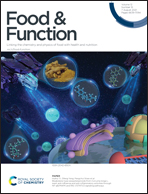Kaempferol attenuates diquat-induced oxidative damage and apoptosis in intestinal porcine epithelial cells†
Abstract
Kaempferol, a flavonol component of plants, is well-known to exhibit multiple bioactivities, such as anti-oxidative and anti-apoptotic effects. However, the underlying mechanisms responsible for the beneficial effects remain elusive. This study was conducted to test the hypothesis that kaempferol attenuated diquat-induced oxidative damage and intestinal barrier dysfunction by ameliorating oxidative damage and apoptosis in intestinal porcine epithelial cells. Compared with the control group, diquat treatment led to enhanced intracellular ROS production, increased mitochondrial depolarization, and apoptosis, which were accompanied by cell cycle arrest at the G1 phase, reduced cell migration, and disrupted intestinal epithelial barrier function. These effects triggered by diquat were reversed by kaempferol. Further study showed that the protective effect of kaempferol was associated with an enhanced mRNA level of genes related to cell cycle progression (cyclin D1, CDK4, and E2F1) and genes implicated in the anti-oxidant system (GSR, GSTA4, and HO-1), up-regulated abundance of tight junctions (ZO-1, ZO-2, occludin, and claudin-4), as well as enhanced Nrf2, an anti-oxidant transcription factor. In conclusion, we revealed a functional role of kaempferol in the intestinal barrier. Ingestion of kaempferol-rich foods might be a potential strategy to improve the integrity and function of enterocytes.



 Please wait while we load your content...
Please wait while we load your content...